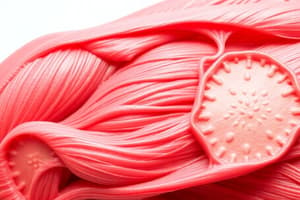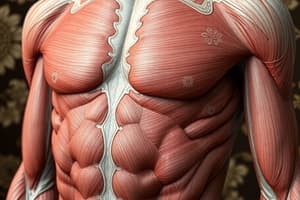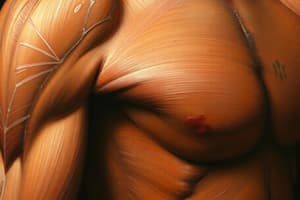Podcast
Questions and Answers
What is the primary characteristic shared by both skeletal and cardiac muscle?
What is the primary characteristic shared by both skeletal and cardiac muscle?
- Anaerobic glycolysis
- Electrical excitability (correct)
- Extensibility
- Elasticity
Which structure serves as a boundary for the contraction unit of muscle cells?
Which structure serves as a boundary for the contraction unit of muscle cells?
- A Band
- H Zone
- M Line
- Z Disc (correct)
What occurs during the sliding filament theory?
What occurs during the sliding filament theory?
- Thick filaments slide past thin filaments towards the Z Disc
- Thin filaments slide past thick filaments towards the M line (correct)
- Thick filaments contract independently of thin filaments
- Filaments lengthen while remaining contracted
What type of muscle contraction occurs when muscle tension exceeds the load?
What type of muscle contraction occurs when muscle tension exceeds the load?
How many ATP molecules are produced during anaerobic glycolysis?
How many ATP molecules are produced during anaerobic glycolysis?
What surrounds each muscle fiber providing structural support?
What surrounds each muscle fiber providing structural support?
What is the role of the sarcoplasmic reticulum in muscle fibers?
What is the role of the sarcoplasmic reticulum in muscle fibers?
Which type of contraction involves the muscle lengthening while generating force?
Which type of contraction involves the muscle lengthening while generating force?
What is the main role of agonist muscles during movement?
What is the main role of agonist muscles during movement?
Which muscle fiber type is primarily associated with endurance activities?
Which muscle fiber type is primarily associated with endurance activities?
What is the function of fixators in muscle action?
What is the function of fixators in muscle action?
What characterizes spatial summation in neural activity?
What characterizes spatial summation in neural activity?
Which cells are primarily responsible for myelination in the peripheral nervous system?
Which cells are primarily responsible for myelination in the peripheral nervous system?
How do mechanical-gated channels function in the context of the sense of touch?
How do mechanical-gated channels function in the context of the sense of touch?
Which of the following best describes the role of antagonists in muscle movement?
Which of the following best describes the role of antagonists in muscle movement?
What type of contraction is produced by summation potentials?
What type of contraction is produced by summation potentials?
What represents the point where a muscle attaches to a moving bone?
What represents the point where a muscle attaches to a moving bone?
Which part of the nervous system consists of the brain and spinal cord?
Which part of the nervous system consists of the brain and spinal cord?
Flashcards
Electrical Excitability
Electrical Excitability
The ability of a muscle cell to receive and respond to stimulation.
Contractility
Contractility
The ability of a muscle to shorten when stimulated.
Extensibility
Extensibility
The ability of a muscle to be stretched.
Elasticity
Elasticity
Signup and view all the flashcards
Epimysium
Epimysium
Signup and view all the flashcards
Endomysium
Endomysium
Signup and view all the flashcards
Perimysium
Perimysium
Signup and view all the flashcards
I Band
I Band
Signup and view all the flashcards
A Band
A Band
Signup and view all the flashcards
Z Disk
Z Disk
Signup and view all the flashcards
M Line
M Line
Signup and view all the flashcards
H Zone
H Zone
Signup and view all the flashcards
Sarcoplasmic Reticulum
Sarcoplasmic Reticulum
Signup and view all the flashcards
Sarcomere
Sarcomere
Signup and view all the flashcards
Sarcolemma
Sarcolemma
Signup and view all the flashcards
Neuromuscular Junction
Neuromuscular Junction
Signup and view all the flashcards
Sliding Filament Theory
Sliding Filament Theory
Signup and view all the flashcards
Aerobic Respiration
Aerobic Respiration
Signup and view all the flashcards
Anaerobic Glycolysis
Anaerobic Glycolysis
Signup and view all the flashcards
Creatine Phosphate
Creatine Phosphate
Signup and view all the flashcards
Isotonic Contraction
Isotonic Contraction
Signup and view all the flashcards
Isometric Contraction
Isometric Contraction
Signup and view all the flashcards
Eccentric Contraction
Eccentric Contraction
Signup and view all the flashcards
Concentric Contraction
Concentric Contraction
Signup and view all the flashcards
Agonist
Agonist
Signup and view all the flashcards
Antagonist
Antagonist
Signup and view all the flashcards
Fixator
Fixator
Signup and view all the flashcards
Synergist
Synergist
Signup and view all the flashcards
Origin
Origin
Signup and view all the flashcards
Insertion
Insertion
Signup and view all the flashcards
Action Potential
Action Potential
Signup and view all the flashcards
Graded Potential
Graded Potential
Signup and view all the flashcards
Summation Potentials
Summation Potentials
Signup and view all the flashcards
Convergent Muscle
Convergent Muscle
Signup and view all the flashcards
Spatial Summation
Spatial Summation
Signup and view all the flashcards
Temporal Summation
Temporal Summation
Signup and view all the flashcards
Salutatory Conduction
Salutatory Conduction
Signup and view all the flashcards
Central Nervous System
Central Nervous System
Signup and view all the flashcards
Peripheral Nervous System
Peripheral Nervous System
Signup and view all the flashcards
Oligodendrocytes
Oligodendrocytes
Signup and view all the flashcards
Schwann Cells
Schwann Cells
Signup and view all the flashcards
Astrocytes
Astrocytes
Signup and view all the flashcards
Microglia
Microglia
Signup and view all the flashcards
Ependymal Cells
Ependymal Cells
Signup and view all the flashcards
Study Notes
Muscle Characteristics
- Electrical excitability: Responsiveness, ability to receive and respond to stimuli
- Contractility: Ability to shorten forcibly when stimulated
- Extensibility: Ability to be stretched
- Elasticity: Ability to recoil to resting length
Muscle Tissue Structures
- Epimysium: Dense irregular connective tissue surrounding an entire muscle
- Perimysium: Fibrous connective tissue surrounding fascicles (groups of muscle fibers)
- Endomysium: Fine areolar connective tissue surrounding each muscle fiber
Sarcomere Structure
- I band: Shortens; contains thin filaments (actin)
- A band: Thick myosin filaments and some actin filaments; dark region within a sarcomere.
- Z disc: Plates delimiting a sarcomere; pulled towards the M line.
- M line: Center of a sarcomere where myosin binds.
- H zone: Only thick myosin filaments, no actin filaments; disappear during contraction.
Skeletal Muscle Fiber Components
- Sarcoplasmic reticulum: Stores and releases calcium ions
- Sarcomere: Smallest contractile unit (functional unit) of a muscle fiber
- Sarcolemma: Muscle fiber plasma membrane
Neurotransmitters & Muscle Action
- Acetylcholine (ACh): Excitatory neurotransmitter at the neuromuscular junction
- Sliding filament theory: Thin (actin) filaments slide past thick (myosin) filaments towards the M-line during contraction.
Energy Production (Respiration)
- Aerobic respiration: Produces 36 ATPs and provides energy for several minutes or longer
- Anaerobic glycolysis: 2 ATPs, lasting 10-30 seconds
- Creatine phosphate: 1 ATP, lasting for about 15 seconds
Muscle Contraction Types
- Isotonic: Muscle shortens because muscle tension exceeds load.
- Isometric: No shortening; muscle tension increases but load is not exceeded.
- Eccentric contraction: Muscle lengthens & generates force
- Concentric contraction: Muscle shortens & generates force.
Muscle Action Types
- Agonist/Prime Mover: Major responsibility for producing specific movement.
- Antagonists: Opposes or reverses particular movement.
- Fixators: Type of synergist that immobilizes a bone or muscle origin to provide a stable base for the prime mover.
- Synergists: Help prime movers.
Muscle Attachment Sites
- Origin: Attachment site on the bone that does not move during muscle contraction.
- Insertion: Attachment site on the bone that moves during muscle contraction.
Skeletal Muscle Function - Control
- Mechanically-gated channels: Open/close in response to a physical distortion in the membrane, a major mechanism underlying touch sensation.
- Action potentials (electrical charges): Propagated across sarcolemma for skeletal muscle. Graded potentials: Signals across short distances. Summation: adding up potentials for stronger contractions
- Somatic system (voluntary) control
Neural System Components
- Central Nervous System (CNS): Brain and spinal cord
- Peripheral Nervous System (PNS): Nerves branching out from the CNS (cranial and spinal nerves).
Cellular components of the nervous system
- Oligodendrocytes, Schwann cells, Astrocytes, Microglia, Ependymal cells
Other muscle/bone information mentioned:
- Rotator Cuff Muscles: Supraspinatus, Infraspinatus, Teres Minor, Subscapularis
- Hamstrings: Biceps femoris, Semitendinosus, Semimembranosus
- Quadriceps: Rectus femoris, Vastus lateralis, Vastus intermedius, Vastus medialis
- List the three types of muscle fibers and describe the function of each, list and describe the major functional divisions of the nervous system.
Studying That Suits You
Use AI to generate personalized quizzes and flashcards to suit your learning preferences.




